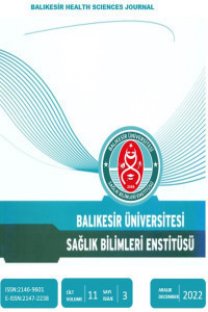Cinsiyete Göre Farklı Yaş Gruplarında Uyku Parametrelerindeki Değişiklikler
Changes in Sleep Parameters in Different Age Groups between Genders
___
- Amore M, Donato PD, Berti A, Palareti A, Chirico C, Papalini A, Zucchini S (2006). Sexual And Psychological Symptoms In The Climacteric Years. Maturitas, 56: 303-11. https://doi.org/10.1016/j.maturitas.2006.09.006 Ancoli-Israel S, Shochat T (2011). Insomnia in older adults. In: Kryger MH, Roth T, Dement WC, eds.Principles and Practice of Sleep Medicine. 5th ed. Philadelphia, PA: Elsevier Saunders, chap 135.
- Ancoli-Israel S, Roth T (1999). Characteristics of insomnia in the United States: results of the 1991 National Sleep Foundation Survey. I. Sleep, 22 (Suppl 2): S347-53.
- Başoğlu ÖK, “Uyku ile ilgili genel tanımlar ve uyku bozuklukları sınıflaması, Türk Toraks Derneği Kitapları,” Uykuda Solunum Bozuklukları” 2015:38-56.
- Blake H, Gerard RW (1937). Brain Potentials During Sleep. American Journal of Physiology, 119:692–703. https://doi.org/10.1152/ajplegacy.1937.119.4.692.
- Census USBot, (2000). Population Project Program, Washington, DC.
- Cofta S, Wysocka E, Piorunek T, Rzymkowska M, Batura- Gabryel H, Torlinski L. (2008). Oxidative stress markers in the blood of persons with different stages of obstructive sleep apnea syndrome, Journal Of Physiology And Pharmacology. Dec;59 Suppl 6:183-90.
- Dement WC. History of Sleep Medicine (2005). Neurologic Clinics, 23: 945-965. https://doi.org/10.1016/j.ncl.2005.07.001
- Falkmarken ND. (2015). “Uyku Fizyolojisi”, Türk Toraks Derneği Kitapları,” Uykuda Solunum Bozuklukları”11-25.
- Gulia KK, Kumar VM (2018). Sleep disorders in the elderly: a growing challenge. Psychogeriatrics,18:155–65. https://doi.org/10.1111/psyg.12319
- Iber C, Ancoli-Israel S, Chesson AL and Quan SF fort he American Academy of Sleep Medicine. The AASM manual 2007 for the scoring of sleep and associated event: rules, terminology and technical specification, 1 ed: Westchester, Illinois : American Academy of Sleep Medicine, 2007.
- Juergens TM, Barczi SR (2007). Sleep. In: Duthie EH, Katz PR, Malone ML, eds. Practice of Geriatrics. 4th ed. Philadelphia, PA: Elsevier Saunders, chap 22. Maggi S, Langlois JA, Minicuci N, Grigoltto F, et al (2015). Sleep complaints in community-dwelling older persons: prevalence, associated factors, and reported causes. Journal of the American Geriatrics Society, 46(2): 161-8. https://doi.org/10.1111/j.15325415.1998.tb02533
- Odens ML, Fox CH. (1995). Adult sleep apnea syndromes. American Family Physician,52:859–66.
- Ohayon MM (2002). Epidemiology of insomnia: what we know and what we still need to learn. Sleep Medicine Reviews, 6: 97-111. https://doi.org/10.1053/smrv.2002.0186
- Ohayon MM, Carskadon MA, Guilleminault C, Vitiello MV. (2004). Meta-analysis of quantitative sleep parameters from childhood to old age in healthy individuals: developing normative sleep values across the human lifespan. Sleep,27:1255. https://doi.org/10.1093/sleep/27.7.1255
- Patil SP. (2010). What every clinician should know about polysomnography. Respiratory Care, 55:1179-95.
- Peppard PE., Young, T., Palta, M., & Skatrud, J. (2000). Prospective study of the association between sleep- disordered breathing and hypertension. The New England Journal of Medicine, 342,:1378– 1384. https://doi.org/10.1056/nejm200005113421901
- Robinson, G. V., Stradling, J. R., & Davies, R. J. (2004). Sleep. 6: obstructive sleep apnoea/hypopnoea syndrome and hypertension. Thorax, 59, 1089–1094. https://dx.doi.org/10.1136%2Fthx.2003.015875
- Shamsuzzaman A.S., Gersh B.J., Somers V.K. (2003). Obstructive sleep apnea: implications for cardiac and vascular disease. The Journal of the American Medical Association, Clinical Cardiology 290, 1906–1914. https://doi.org/10.1001/jama.290.14.1906
- Stanley N. (2005).The physiology of sleep and the impact of ageing. Europen Urology Supplements,6: 17-23. https://doi.org/10.1016/S15699056(05)80003-X
- Sukegawa T, Itoga M, Seno H, Miura S, Inagaki T, Saito W, et al. (2003). Sleep disturbances and depression in the elderly in Japan. Psychiatry And Clinical Neurosciences,57(3): 265-70). https://doi.org/10.1046/j.14401819.2003.01115.x Turkish Statistical Institute, Seniors with Statistics, 2020 Tuik.gov.tr, Publication date: March 18, 2021, Number:37227. https://data.tuik.gov.tr/Bulten/Index?p=Elderly- Statistics-2020-37227. Acces date: 18.03.2021.
- Turkey Demographic and Health Survey. Hacettepe University Institute of Population Studies, Ankara, 2008. pp:117.
- WHO, World Health Organization. (1996), Research on the menopause in the 1990s.World Health Organ Tech Rep Ser 1996;866:1-107.
- Young, T., Shahar, E., Nieto, F. J., Redline, S., Newman, A. B., Gottlieb, D. J., et al. (2002). Predictors of sleep-disordered breathing in ommunity-dwelling adults: the sleep heart health study. Archives of Internal Medicine, 162, 893–900. https://doi.org/10.1001/archinte.162.8.893
- ISSN: 2146-9601
- Yayın Aralığı: Yılda 3 Sayı
- Yayıncı: BALIKESİR ÜNİVERSİTESİ
Endoskopik Retrograd Kolanjio-Pankreatografi İşleminde Hemşirenin Rol veSorumlulukları
Hemşirelik Sınıflama Sistemlerine Göre Ağız ve Diş Sağlığı Hizmetlerinde HemşirelikSüreci
İnfertil Kadınların “Kadın Olma”ya İlişkin Tanımları ve Görüşleri: Bir Nitel Araştırma
Kamile KABUKCUOĞLU, Ayşe DELİKTAŞ DEMİRC
Hastanede Yatarak Tedavi Olan Hastaların Yaşam Kalitesini EtkileyenSosyodemografik Faktörler
Hakan BAYDUR, Şemsinnur GÖÇER, Nursel ÜSTÜNDAĞ ÖCAL
Merve ŞAHİN, Cihan KOCAİRi, Fatma DEMİRKIRAN
Hormonlar ya da Hormon Benzeri Maddeler ve KalıntılarınınVeteriner Hekimliğindeki Önemi
Hasan SUSAR, Murat ÇELEBİ, İzzet KARAHAN
Doğum Öncesi Eğitimin Doğum Sonu Yaşam Kalitesi Üzerine Etkisi
Kevser ÖZDEMİR, Yasemin BAŞKAYA, Şilan BEYTAŞ, Büşra TURTUL
PKOS Hastalarında Yüksek Kan Basıncı Sıklığı ve Bunun Klinik ve LaboratuvarParametrelerle İlişkis
